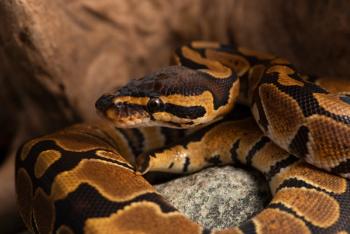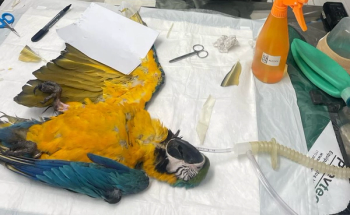
Managing respiratory diseases in exotic mammals (Proceedings)
Respiratory disease in small exotic mammals is caused by a variety of etiologies but infectious causes predominate. Both upper and lower airway disease is seen and in rabbits and rodents, animals that are obligate nasal-breathers, upper respiratory disease can be as problematic as lower airway disease.
Respiratory disease in small exotic mammals is caused by a variety of etiologies but infectious causes predominate. Both upper and lower airway disease is seen and in rabbits and rodents, animals that are obligate nasal-breathers, upper respiratory disease can be as problematic as lower airway disease. Species predilection for specific etiologies exists, however definitive diagnosis is necessary for the effective management of respiratory disease in exotic mammals.
Rabbits
Infectious etiologies
Historically, respiratory disease in rabbits was synonymous with pasteurellosis, or “snuffles”, with P. multocida implicated as the etiological agent. More accurately, respiratory disease in rabbits often has an infectious etiology but can be caused by P. multocida, Bordetella bronchiseptica, Staphylococcus sp., Pseudomonas sp., and other bacteria including anaerobic bacteria. Most respiratory pathogens of rabbits are transmitted through respiratory exposure of aerosolized pathogen from infected rabbits. Direct contact and fomite transmission is also possible. Incubation periods vary as many rabbits remain subclinical carriers of P. multocida, a commensal organism that becomes pathogenic when the host is immunodeficient or stressed. Once established in tissues, the infection spreads to contiguous tissues and can involve the nares, sinuses, nasolacrimal duct, conjunctiva, Eustachian tube, middle ear, trachea, bronchi, and lungs. Hematogenous spread also facilitates infection of the middle ear, lungs, and viscera.
Rhinitis and sinusitis are the most common forms of pasteurellosis and infected animals display mucopurulent discharge from the eyes and nares. As rabbits groom their face, the discharge will accumulate on the medial aspects of the forepaws, a tell-tale sign for the clinician. Sneezing is often noted. Signs of disease may subside but patients often harbor infection despite resolution of clinical signs. Chronic infections within the thorax can persist beyond the acute phase of injection. The resulting pleuropneumonia is characterized by fibrinopurulent exudate in the airways and significant respiratory effort in advanced cases.
Diagnosis is based on physical examination findings including respiratory auscultation. Sneezing, snoring, nasal discharge, matted fur on face and forepaws, along with nasopharyngeal rales but normal lung sounds indicate upper airway disease. Anorexia, weight loss, depression, dyspnea, pale mucous membranes, and pulmonary rales indicate lower airway disease. Hyperthermia can be noted with both upper and lower airway disease. Radiographic evaluation can be useful to differentiate pneumonia from neoplasia or cardiovascular disease. Skull radiographs, with careful positioning, can provide information regarding the nares, sinuses, and ears. Computed tomography may be superior to plain radiography in many cases. If infectious respiratory disease is suspected, culture and sensitivity testing is warranted. Hematology will provide information regarding the presence of systemic disease but is not a reliable indicator of infection.
Administration of oral antimicrobial agents is limited in rabbits and other hind-gut fermenting small mammals to those that do not impact the gastrointestinal flora. Oral beta-lactam drugs, including penicillins and cephalosporins, in addition to macrolides must be avoided. Floroquinolones, chloramphenicol, and trimethoprim-sulfa are effective oral options for antimicrobial therapy. Additionally, some beta-lactam antibiotics can be administered with caution by parenteral route.
Non-infectious etiologies
Any space occupying mass in the respiratory tract can cause significant respiratory distress from airway obstruction. Open mouth breathing is an indication that serious respiratory compromise has occurred. Neoplasia of the nasal tubinates and lung metastasis from tumors elsewhere are the most common presentations of non-infectious respiratory disease of rabbits. Thymomas are not uncommon in adult rabbits and the clinical signs of tachypnea and tachypnea are associated with the tumor growth in the cranial mediastinum. Bilateral exophthalmos, especially when the patient is stressed, can be observed due to compromised blood return to the heart. Tracheal edema can occur secondary to trauma caused by intubation or prolonged intubation.
Rodents
Guinea pigs
Bacterial pneumonia is the most significant respiratory disease seen in guinea pigs and the causative agents include Bordetella bronchiseptica and Streptococcus pneumoniae. Rabbits and dogs are carriers of Bordetella and many species can serve as asymptomatic carriers of Streptococcus. Stress is a predisposing factor for disease development. Transmission is by direct contact, aerosolization of infectious particles, or by fomites. Clinical signs often include inappetence, ocular and nasal discharge, and dyspnea secondary to purulent bronchopneumonia. Culture and sensitivity testing of exudate can be diagnostic when correlated with clinical signs. Radiography is useful to assess extent of respiratory tract involvement. Chloramphenicol, trimethoprim-sulfa, and enrofloxacin are commonly used antibiotics in guinea pigs. Anorexia is an occasional sequela to administration of oral chloramphenicol. In these cases, injectable florfenicol can be used.
Prairie dogs
Respiratory disease is common in prairie dogs. In advanced cases, these patients present with significant dyspnea, cyanosis, nasal discharge, anorexia, and lethargy. Several factors predispose prairie dogs to respiratory disease including the propensity for obesity and caging factors. When caused by high levels of dust, humidity, or poor ventilation, respiratory signs may resolve when caging is improved. Infectious causes of respiratory disease in prairie dogs include opportunistic pathogens such as Escherichia coli, Klebsiella,Pasteurella, Pseudomonas, and Mycoplasma. The upper and lower airways are often involved. Clinical diagnosis is made by evaluation of pulmonary radiography, cytology, hematology, and culture with sensitivity of infectious material.
Rabbit and rodent dental malocclusion can result in clinical signs consistent with upper airway disease. The incisor teeth are hypsodont, with more root below the gumline than crown above, and continuously grow throughout the animal's life. Some species, most notably the rabbit, guinea pig, chinchilla, and prairie dogs, also have hypsodont cheek teeth. Trauma, inappropriate diet, and disease can cause abnormal growth of these teeth and subsequent malocclusion. When tooth roots are affected, the associated inflammation and bony reaction will impinge on surrounding soft tissue structures including the nasal-lacrimal duct, eyes, and nasal passage. Conjunctivitis, epiphora, nasal and ocular discharge, exophthalmia, and facial swellings can occur. Repeated trauma from cage chewing and the resulting incisor malocclusion has been implicated in odontoma formation in the prairie dog. These patients exhibit acute onset of dyspnea and open-mouth breathing due to obstructed nasal airflow as the tumor impinges on the nasal passage. External signs of the tumor may not be apparent. Radiographs taken of the skull will reveal a bullous radiopacity in the apical area of the incisors. These patients will be highly stressed due to their inability to breathe making sedation useful; however care must be taken to ensure adequate ventilation. Management with nasal decongestants, antibiotics, and steroids may be palliative but surgical management has been successful. Incisor extraction in rodent species is extremely difficult and complications include tooth fracture, jaw fracture, and incomplete removal. Odontoma management usually involves performing a rhinotomy and developing a stoma into the nasal passage caudal to the occlusion through which the animal can breathe. The prognosis for prairie dogs presenting for severe dyspnea is poor.
Rats
Arguably, respiratory disease is the most common disease presentation in pet rats. Bacterial pathogens, predominantly Mycoplasma pulmonis, Streptococcus pneumonia, and Corynebacterium leutscheri, are responsible for disease development in the majority of cases. Viral pathogens are possible but rarely cause serious disease in rodents by themselves. Working synergistically however, they can co-infect with one of the bacterial pathogens, notably M. pulmonis, to cause chronic respiratory disease (CRD). Rats with CRD can live 2-3 years with signs of disease being variable. Often S. pneumonia is a co-pathogen in bacterial pneumonia cases of rats. CRD involves both the upper and lower respiratory tract and clinical signs are absent initially. Early clinical signs are vague and include an unthrifty appearance, weight loss, hunched posture, ruffled coat, epiphora with red tears, and nasal discharge. A head tilt may also be noted. Disease expression varies greatly due to differences in host environment (co-infection with other respiratory pathogens, immune status of animal, presence of respiratory irritants such as cage ammonia levels) and pathogen virulence. Historically, the aim of treatment has been to target M. pulmonis by using tetracycline antibiotics, however alone, or in combination with other antibiotics, doxycycline is unlikely to cure CRD. The current recommended treatment includes concurrent use of enrofloxacin (10 mg/kg q12h) and doxycycline hyclate (5 mg/kg q12h). Many rats develop severe respiratory damage secondary to infection due to an exaggerated cellular immune response to mycoplasma. Treatment may reduce clinical signs but animals chronically infected may show signs of middle ear infections, ciliostasis, bronchiectasis, bronchiolectasis, and lung abscesses.
S. pneumoniae rarely causes respiratory disease alone but can cause sudden onset pneumonia in patients co-infected with bacterial or viral respiratory pathogens. Severely affected young rats may succumb rapidly but mature rats will demonstrate dyspnea, snuffling, and abdominal press when breathing. Cytology of the purulent nasal exudate will demonstrate gram-positive diplococcic providing a presumptive diagnosis. Treatment must be aggressive and some clinicians recommend the use of penicillins (Clavamox, 130 mg/kg PO; Exotic Companion Medicine Handbook for Veterinarians. Johnson-Delaney C.A. 1996. Wingers Publishing, Inc., Lake Worth, FL.).
Management of respiratory disease
Oxygen supplementation is indicated for patients experiencing respiratory distress. The small size of exotic mammal patients is well suited for oxygen chambers however oxygen cages are expensive and often unavailable. Oxygen concentrators absorb nitrogen from room air to increase the concentration of oxygen emitted, often >95% fractional inspired oxygen (FiO2), and can be used to achieve therapeutic levels of oxygen (>40% FiO2) in small enclosures used to hospitalize exotic patients.
Nebulization as an adjunct therapy for management of respiratory is not only beneficial in delivering medications directly into the airways, it helps maintain the hydration status of respiratory membranes to allow clearance of secretions. Nebulizing hypertonic saline decreases edema associated with the pulmonary tissue resulting in an opening of the airways. Albuterol inhalation solution developed for children with asthma has also been effective for management of respiratory disease in rats. Its bronchodilator action opens airways and alleviates bronchospasm. Dosing is empirical and extrapolated from human use (0.042% Albuterol Sulfate Inhalation Solution or 0.083% solution diluted with 3 ml saline, 15 min. q8-12h for 14 days). Antimicrobial therapy may be incorporated into nebulization therapy (0.5 ml gentocin injectable, 100 mg/ml).
Resources
Exotic Animal Formulary, 3rd ed. Carpenter J.W. 2001. Elsevier, St. Louis, MO.
Ferrets, Rabbits, and Rodents; Clinical Medicine and Surgery, 2nd ed. Quesenberry K.E., Carpenter J.W., eds. 2004, Saunders, Philadelphia, PA.
Manual of Exotic Pet Practice. Mitchell M.A. and Tully T. N. 2009. Saunders, St. Louis, MO.
Newsletter
From exam room tips to practice management insights, get trusted veterinary news delivered straight to your inbox—subscribe to dvm360.






